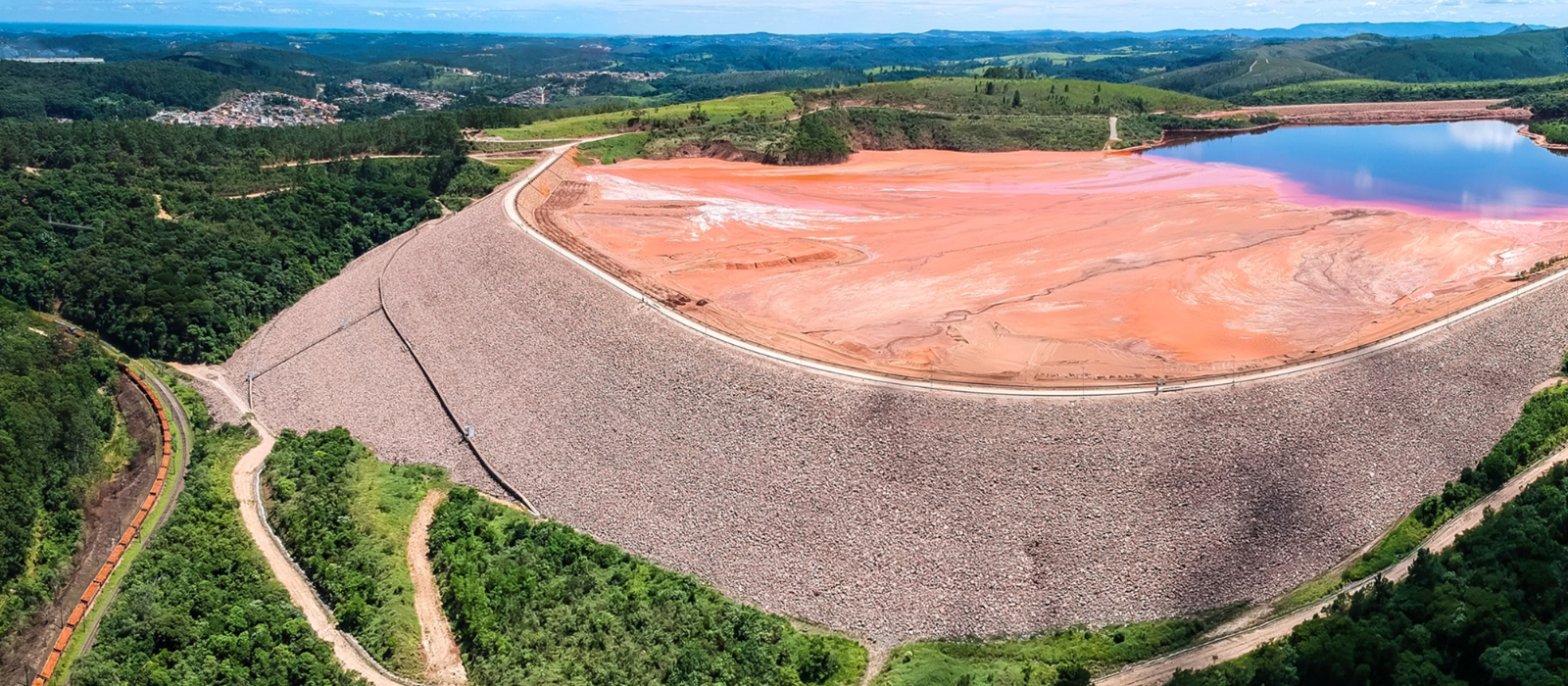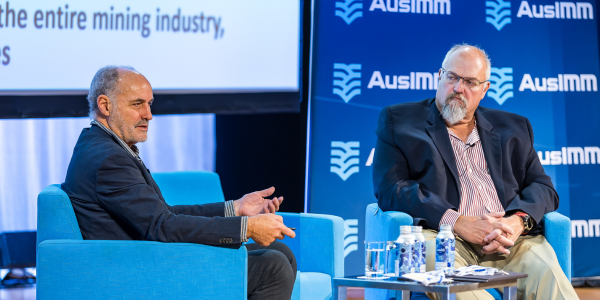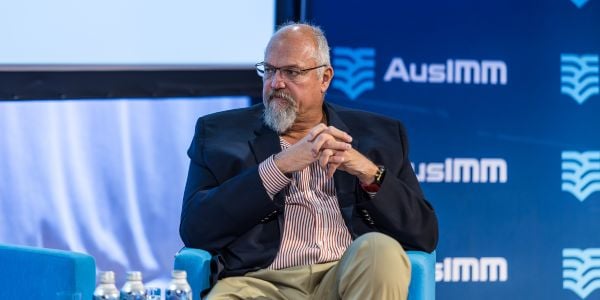Digging deep on risk, resilience and the future of tailings dam design

This article originally appeared on The Rock Wrangler and is republished here with permission.
Tailings engineers aren’t just designing structures - they’re safeguarding legacies. That was the resounding message from Professor David Williams FAusIMM and Christopher Hatton during their candid and wide-ranging keynote at AusIMM's Life of Mine | Mine Waste and Tailings Conference 2025 in Brisbane.
The session was refreshingly different. Delivered as a seated conversation, the exchange blended hard-earned insight with technical clarity, offering a no-frills exploration of tailings engineering that cut through the noise of regulation, risk, and resilience.

Prof David Williams FAusIMM (left) and Christopher Hatton at AusIMM's Life of Mine | Mine Waste and Tailings Conference 2025.
The truth about tailings engineering
Christopher Hatton, senior program leader and director at WSP in the US, opened with a stark admission: “Tailings dam design, for all practical purposes, is a guess. It’s an educated guess - but still a guess. We spend the entire period of constructing the dam verifying that our guess was correct.”
It’s a provocative truth that underscores the complexity of the discipline. Tailings engineers don’t graduate with tailored degrees. As Chris put it, “Universities produce civil engineers. We turn them into tailings engineers in the field.”

Chris outlined a development arc for early-career engineers that favours practical immersion over titles. “Your first 10 years should be spent in the field - drilling, testing, observing construction. That’s when you’re least expensive and most absorbent. It’s how you build judgment.”
He also cautioned against rapid job-hopping and title-chasing, describing them as career killers. “Every move you make writes a story on your CV - and you don’t get to control the narrative. It might say you’re chasing money, can’t handle conflict, or just don’t finish hard things.”
Tailings failures: more than engineering issues
David Williams, director of the Geotechnical Engineering Centre at The University of Queensland, offered a global perspective, focusing on high-profile failures and the systemic changes they triggered - or failed to.
David described the 1965 El Cobre disaster in Chile as a turning point. The magnitude 7.6 earthquake-triggered failure led to a seismic shift in design thinking. “It was tragic, but it spurred real change. The industry banned upstream dam construction in seismic zones long before regulators did. They moved from two-to-one slopes to four-to-one. That doubled the margin of stability.”

He contrasted this with the more recent disasters in Brazil - Samarco in 2015 and Brumadinho in 2019 - which exposed the fragility of governance in tailings management.
“Brumadinho was different. It wasn’t just a Brazilian failure - it was a global one. The Church of England, as an investor, helped catalyse a worldwide response. That tells you the pressure isn’t just coming from engineers anymore. It’s coming from markets and shareholders.”
The financial fallout of these events is sobering. BHP and Vale lost billions in share value overnight. In the case of Mount Polley in Canada, Imperial Metals’ share price collapsed from C$15 to under C$1. “They nearly didn’t survive. The reputational damage was immense. These aren’t just engineering failures - they’re corporate catastrophes,” David said.
Legal mindsets, cultural divides
The conversation then shifted to a revealing comparison between English-speaking and Latin-speaking regulatory environments. In English-speaking jurisdictions like Australia and Canada, David explained, compliance with industry guidelines such as those from Australian National Committee on Large Dams (ANCOLD) or Canadian Dam Association (CDA) is typically deemed sufficient in law.
“In these regions, you’re innocent until proven guilty. You’re judged against what a reasonable engineer would do. In Latin-speaking countries, it’s the opposite. You’re guilty until proven innocent. If something goes wrong, you’re arrested first, then questioned.”
He pointed to Brazil’s post-Brumadinho legal reforms, which now mandate upstream dams be decommissioned using remote-controlled equipment, even in cases where manual deconstruction might be safer and more efficient. “It’s an example of rigid law overriding engineering judgment. It adds cost, complexity, and uncertainty.”
Design simplicity and drainage above all
For Chris, good design begins and ends with simplicity. “Don’t fall in love with intricate filter systems. If a reviewer opens your drawings and sees a labyrinth of filter layers and transition zones, they’ll know immediately it’s a liability.”
Instead, he advocates for drainage-driven designs. “There are three rules in tailings dam design: drainage, drainage, and drainage. If you get that right - and you maintain a wide, dry beach - most problems disappear.”
Chris also emphasised the importance of centreline designs over downstream or upstream configurations. “Centreline dams are my favourite. They balance capital cost with performance. They’re accessible, they can handle high raise rates, and they perform well in seismic zones.”
Beach slopes and behavioural clues
David reiterated the need for deposition strategies that align with long-term closure plans. “Design your tailings placement so you’re building your closure landform from day one. Relying on mechanical regrading post-closure is more expensive and risk-prone. If you can shape it hydraulically during operations, do it.”
He warned against tailings deposition towards the dam wall - a practice that increases phreatic pressures and liquefaction risk. “If super-elevated tailings liquefy, they can overtop the pond. It’s a scenario with potentially fatal consequences.”
CPTs, pseudo-data, and proper interpretation
The conversation turned to the interpretation of CPT (cone penetration test) data - a tool now ubiquitous in tailings assessment. David cautioned against blind reliance.
“Many of the correlations used in CPT analysis are based on clean sands or clays - not tailings. Tailings sit somewhere in between. You need to be cautious. Use multiple indicators of strength. Correlate. Interrogate. Don’t assume.”
Chris added a pointed reminder: “Stay true to the science. Don’t build in layers of conservatism without justification. That doesn’t help the industry - it distorts reality and drives bad decisions.”
The next generation problem
Both presenters issued a sobering warning about the future talent pipeline.
“The attrition of senior people will be sudden and catastrophic,” Chris said. “We’re already facing it in ITRBs [Independent Tailings Review Boards] and mentor programs. Once that institutional memory is gone, it’s gone.”
David agreed. “It’s easier to put a grey-haired person on a review board because the experience is evident. But we need to start bringing in the next generation now, while the experienced voices are still in the room. Succession planning isn’t optional - it’s urgent.”
Final reflections
The keynote closed not with solutions, but with convictions. Build simple. Build stable. Design for the future. Train with purpose. And don’t forget that every tailings dam is a permanent structure. Its stability - or failure - will outlast the mine that built it.
As Chris put it, “You don’t clock in and clock out of this profession. It’s a life’s journey. Every project, every pore pressure, every decision - it all matters.”
For a profession built on judgment, context, and consequence, the message was clear: what we build today defines the trust, safety, and sustainability of the sector tomorrow.